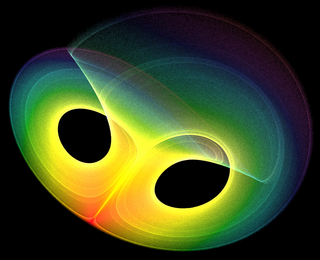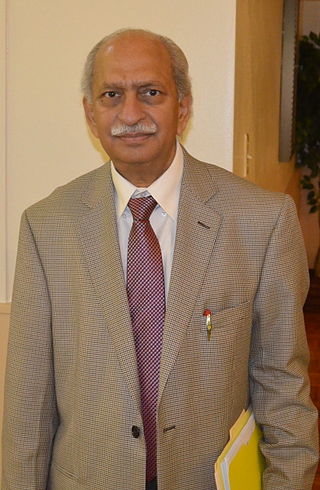
David Hilbert was a German mathematician and one of the most influential mathematicians of the 19th and early 20th centuries. Hilbert discovered and developed a broad range of fundamental ideas including invariant theory, the calculus of variations, commutative algebra, algebraic number theory, the foundations of geometry, spectral theory of operators and its application to integral equations, mathematical physics, and the foundations of mathematics.

Differential geometry is a mathematical discipline that studies the geometry of smooth shapes and smooth spaces, otherwise known as smooth manifolds. It uses the techniques of differential calculus, integral calculus, linear algebra and multilinear algebra. The field has its origins in the study of spherical geometry as far back as antiquity. It also relates to astronomy, the geodesy of the Earth, and later the study of hyperbolic geometry by Lobachevsky. The simplest examples of smooth spaces are the plane and space curves and surfaces in the three-dimensional Euclidean space, and the study of these shapes formed the basis for development of modern differential geometry during the 18th and 19th centuries.
Mathematics is an area of knowledge that includes the topics of numbers, formulas and related structures, shapes and the spaces in which they are contained, and quantities and their changes. These topics are represented in modern mathematics with the major subdisciplines of number theory, algebra, geometry, and analysis, respectively. There is no general consensus among mathematicians about a common definition for their academic discipline.
Haskell Brooks Curry was an American mathematician and logician. Curry is best known for his work in combinatory logic, whose initial concept is based on a paper by Moses Schönfinkel, for which Curry did much of the development. Curry is also known for Curry's paradox and the Curry–Howard correspondence. Named for him are three programming languages: Haskell, Brook, and Curry, and the concept of currying, a method to transform functions, used in mathematics and computer science.

Analysis is the branch of mathematics dealing with continuous functions, limits, and related theories, such as differentiation, integration, measure, infinite sequences, series, and analytic functions.
Foundations of mathematics is the study of the philosophical and logical and/or algorithmic basis of mathematics, or, in a broader sense, the mathematical investigation of what underlies the philosophical theories concerning the nature of mathematics. In this latter sense, the distinction between foundations of mathematics and philosophy of mathematics turns out to be vague. Foundations of mathematics can be conceived as the study of the basic mathematical concepts and how they form hierarchies of more complex structures and concepts, especially the fundamentally important structures that form the language of mathematics also called metamathematical concepts, with an eye to the philosophical aspects and the unity of mathematics. The search for foundations of mathematics is a central question of the philosophy of mathematics; the abstract nature of mathematical objects presents special philosophical challenges.

Mathematical physics refers to the development of mathematical methods for application to problems in physics. The Journal of Mathematical Physics defines the field as "the application of mathematics to problems in physics and the development of mathematical methods suitable for such applications and for the formulation of physical theories". An alternative definition would also include those mathematics that are inspired by physics, known as physical mathematics.
Proof theory is a major branch of mathematical logic and theoretical computer science within which proofs are treated as formal mathematical objects, facilitating their analysis by mathematical techniques. Proofs are typically presented as inductively-defined data structures such as lists, boxed lists, or trees, which are constructed according to the axioms and rules of inference of a given logical system. Consequently, proof theory is syntactic in nature, in contrast to model theory, which is semantic in nature.
Lists of mathematics topics cover a variety of topics related to mathematics. Some of these lists link to hundreds of articles; some link only to a few. The template to the right includes links to alphabetical lists of all mathematical articles. This article brings together the same content organized in a manner better suited for browsing. Lists cover aspects of basic and advanced mathematics, methodology, mathematical statements, integrals, general concepts, mathematical objects, and reference tables. They also cover equations named after people, societies, mathematicians, journals, and meta-lists.

David Orlin Hestenes is a theoretical physicist and science educator. He is best known as chief architect of geometric algebra as a unified language for mathematics and physics, and as founder of Modelling Instruction, a research-based program to reform K–12 Science, Technology, Engineering, and Mathematics (STEM) education.
The Mathematics Subject Classification (MSC) is an alphanumerical classification scheme that has collaboratively been produced by staff of, and based on the coverage of, the two major mathematical reviewing databases, Mathematical Reviews and Zentralblatt MATH. The MSC is used by many mathematics journals, which ask authors of research papers and expository articles to list subject codes from the Mathematics Subject Classification in their papers. The current version is MSC2020.
For classical dynamics at relativistic speeds, see relativistic mechanics.
In mathematics, secondary calculus is a proposed expansion of classical differential calculus on manifolds, to the "space" of solutions of a (nonlinear) partial differential equation. It is a sophisticated theory at the level of jet spaces and employing algebraic methods.
Elliott Mendelson was an American logician. He was a professor of mathematics at Queens College of the City University of New York, and the Graduate Center, CUNY. He was Jr. Fellow, Society of Fellows, Harvard University, 1956–58.
Mathematics is a field of study that investigates topics such as number, space, structure, and change.
Mathematics is a broad subject that is commonly divided in many areas that may be defined by their objects of study, by the used methods, or by both. For example, analytic number theory is a subarea of number theory devoted to the use of methods of analysis for the study of natural numbers.

Simon Wolfe Saunders is a British philosopher of physics. He is noted for his work on quantum mechanics, on identity and indiscernibility in physics, and on structural realism.

Ravi P. Agarwal is an Indian mathematician, Ph.D. sciences, professor, professor & chairman, Department of Mathematics Texas A&M University-Kingsville, Kingsville, U.S. Agarwal is the author of over 1000 scientific papers as well as 30 monographs. He was previously a professor in the Department of Mathematical Sciences at Florida Institute of Technology.
Djairo Guedes de Figueiredo is a Brazilian mathematician noted for his researches on differential equations, elliptic operators, and calculus of variations. He is considered the greatest analyst from Brazil. He was the president of the Brazilian Mathematical Society from 1977 to 1979.






